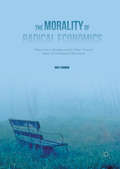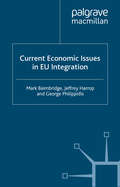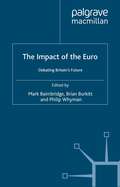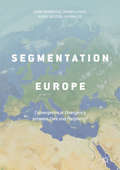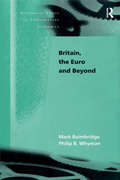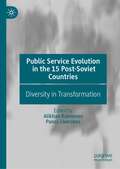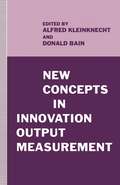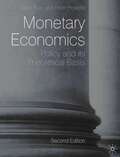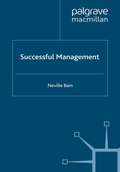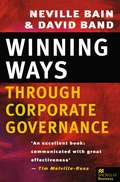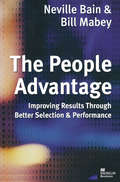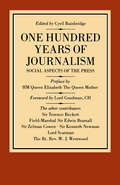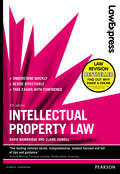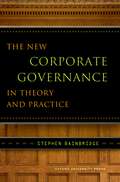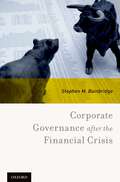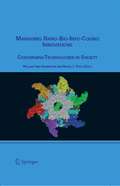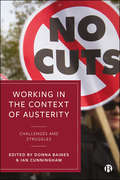- Table View
- List View
The Morality of Radical Economics: Ghost Curve Ideology and the Value Neutral Aspect of Neoclassical Economics
by Ron P. BaimanThis book is in equal parts a treatise on morality and economics, a critique of neoclassical orthodoxy, a brief for replacing mainstream economics with a radical political economics, and an argument for the abandonment of neoliberal capitalism in favor of democratic socialism. It includes a detailed proposal for a "demand and cost" alternative to "supply and demand" analysis and an in-depth technical critique of both neoclassical "high theory" and "applied microeconomic analysis" demonstrating that these are not only infeasible or immoral, but have directly contributed to public policy disasters. Further, the book suggests that only a moral economics in the form of radical political economy can address the looming economic and environmental crises of today’s world.Baiman begins with an introduction to morality and ethics in both general sciences and in economics in particular. He then guides readers through evidence of how neoclassical economics has not only failed to remain objective and value-free, but has become an ideology of apologetics protecting an immoral system. In addition to breaking down real-world examples to demonstrate his assertions, Baiman analyzes a theoretical Utopia design exercise. He concludes by arguing that the only form of economics that supports widely shared human values—such as social equity, democracy, and solidarity—is so-called "radical economics", and that all true economics science should be directed toward achieving more socially productive economic activity. An invaluable guide to morality and economics, this book will appeal to researchers and teachers looking to change the way we think about economics, policy, and society.
Current Economic Issues in EU Integration
by M. Baimbridge J. Harrop G. PhilippidisThis book examines selected pertinent topics on issues relating to current and future EU developments. In its initial sections, the book focuses on an array of wide ranging micro (agriculture, industry and competition) and macro (EMU, regional convergence and enlargement) issues. A final section is reserved for discussion on Britain's future relationship with the EU. In particular, the book posits possible alternative strategies (e.g. NAFTA membership and policy frameworks) and examines these from both a theoretical and empirical perspective.
Crisis in the Eurozone: Causes, Dilemmas and Solutions
by M. Baimbridge P. WhymanThis book explores the background of the eurozone crisis, outlining a number of potential solutions. It attempts to discover if the problems could have been anticipated, and examines how well have the fiscal EMU rules been adhered to and how appropriate they are.
The Impact of the Euro: Debating Britain's Future
by Mark Baimbridge B. Burkitt P. WhymanEconomic and Monetary Union (EMU) will have far-reaching consequences for participating nations. This book contains a unique and editorially neutral collection of key arguments favouring and opposing membership. The economic and policy implications are evaluated by distinguished economists, whilst the impact upon national sovereignty and the world of work is debated by prominent MPs and representatives of business and trade union organisations. The text provides an unbiased, comprehensive and 'readable' resource for specialist students and a general readership.
The Segmentation of Europe: Convergence or Divergence between Core and Periphery?
by Mark Baimbridge Ioannis Litsios Karen Jackson Uih Ran LeeThis book explores economic developments across Europe in relation to its apparent segmentation, as disparities widen between core and periphery countries. In contrast to previous literature, the scope of analysis is extended to Europe as a continent rather than confining it solely to the European Union, thereby providing the reader with greater insight into the core/periphery nexus. The authors commence with a critical appraisal of economic thinking in relation to regional trade agreements and monetary integration. In relation to a number of EU economies, the book addresses issues of a liquidity trap, deflation, and twin deficits, together with the interconnection between exchange rates and current account balances. Importantly, they extend the discussion of segmentation through a series of focused case studies on Russia, Brexit and emergence of the mega-regionals.
Britain, the Euro and Beyond (Alternative Voices in Contemporary Economics)
by Mark Baimbridge Philip B. WhymanThis important book provides an analysis of the economic relationship between Britain and the EU and discusses the future direction in which this relationship might develop. It examines the historic and contemporary costs and benefits of EU membership, and assesses whether this has been a burden or a benefit for the British economy. In addition the authors assess current trends and developments, most notably in the area of participation in Economic and Monetary Union (EMU) and the consequences that this would have. Questions of fiscal federalism, the development of a minimum level of social policy for Europe, together with the likely impact on business and trade unions are also considered. The authors then discuss potential future scenarios, including a more flexible loose membership arrangement or complete withdrawal, and the affect that a range of options might have on the British economy.
Britain, the Euro and Beyond (Alternative Voices in Contemporary Economics)
by Mark Baimbridge Philip B. WhymanThis important book provides an analysis of the economic relationship between Britain and the EU and discusses the future direction in which this relationship might develop. It examines the historic and contemporary costs and benefits of EU membership, and assesses whether this has been a burden or a benefit for the British economy. In addition the authors assess current trends and developments, most notably in the area of participation in Economic and Monetary Union (EMU) and the consequences that this would have. Questions of fiscal federalism, the development of a minimum level of social policy for Europe, together with the likely impact on business and trade unions are also considered. The authors then discuss potential future scenarios, including a more flexible loose membership arrangement or complete withdrawal, and the affect that a range of options might have on the British economy.
Public Service Evolution in the 15 Post-Soviet Countries: Diversity in Transformation
by Alikhan Baimenov Panos LiverakosA unique study of public service evolution in the 15 post-soviet countries from independence to date. It reveals the diversity in their transformation shaped by historical and cultural traditions and the soviet legacy they inherited, as well as by the impact of the political will of ruling elites, all of which influenced the socio-economic and governance models these countries adapted. Its value lays with the fact that it is a collaborative outcome of prominent practitioners, who actively participated in the transformation process, and leading scholars representing all 15 post-soviet countries. It is valuable addition to the body of knowledge of public administration, allowing for improved understanding of the complexity and depth of change that has taken place over the past 30 years. It provides an in-depth analysis of the public service reform process; a subject relevant to the countries of the Region and beyond.
New Concepts in Innovation Output Measurement
by Donald Bain A. KleinknechtThis collection of papers describes advances in the measurement of innovation output, principally through the use of a new technique based on scanning of trade and technical journals. Experience in several countries is assessed and the strength and weaknesses of the technique discussed. The conclusion is that, taken together with recent advances in the design of questionnaires for postal surveys of innovation, this technique provides a radically improved data source for testing innovation theories and for effective policy analysis.
Monetary Economics: Policy and its Theoretical Basis
by Keith Bain Peter HowellsThis fully revised second edition of Bain and Howells' Monetary Economics provides an up-to-date examination of monetary policy as it is practised and the theory underlying it. The authors link the conduct of monetary policy to the IS/PC/MR model and extend this further through the addition of a simple model of the banking sector. They demonstrate why monetary policy is central to the management of a modern economy, showing how it might have lasting effects on real variables, and look at how the current economic crisis has weakened the ability of policymakers to influence aggregate demand through the structure of interest rates. The second edition: features a realistic account of the conduct of monetary policy when the money supply is endogenous provides a detailed and up-to-date account of the conduct of monetary policy and links this explicitly to a framework for teaching macroeconomics includes recent changes in money market operations and an examination of the problems posed for monetary policy by the recent financial crisisMonetary Economics is an ideal core textbook for advanced undergraduate modules in monetary economics and monetary theory and policy.
Successful Management
by N. BainThis book provides a guide to successful management. Managers need to set the right objectives for the company and clear objectives for themselves. A general manager must develop new strategies that are relevant to the environment and are based on the core competences of the corporation. These strategies will need to yield a long term competitive advantage so that they significantly increase the value of the company over time. This book, by the Chief Executive of a major multinational company, provides many insights and thoughtful consideration of important aspects of successful management.
Winning Ways through Corporate Governance
by Neville Bain David BandThe motivation for writing this book is the authors' deeply held conviction that good governance is an essential element for any organisation that wishes to maximise its effectiveness. They are not alone in observing that in many cases companies or other organisations that perform badly are often poorly governed. Indeed, the key explanation for poor performance is often poor governance. This observation is not limited geographically and there are many examples from around the world. Concern with good governance is not just limited to the free enterprise system. It is universal.
The People Advantage: Improving Results Through Better Selection and Performance
by Neville Bain Bill MabeyThe main source of competitive advantage for an organisation rests in its people. Many companies claim that its people are the greatest asset of the company, but the evidence is that few behave accordingly. Indeed, when managers are appointed to new important positions, such as their first general management position, few receive any special training for this role. The evidence is that most appointees are appointed on the basis of their track record, and not through any attempt to evaluate the new position and to match the candidate's objectively measured skill base against the core competencies needed for that job. This book demonstrates the many ways that the careful selection of individuals and teams can add value to the enterprise. It also demonstrates that there are methods by which teams can be enhanced through utilising and understanding the diversity of the different styles of the individuals.
Law Express: Intellectual Property Law
by David Bainbridge Claire HowellThe Law Express series is designed to help you revise effectively. This book is your guide to understanding essential concepts, remembering and applying key legislation and making your answers stand out!
The New Corporate Governance in Theory and Practice
by Stephen BainbridgeForty years ago, managerialism dominated corporate governance. In both theory and practice, a team of senior managers ran the corporation with little or no interference from other stakeholders. Shareholders were essentially powerless and typically quiescent. Boards of directors were little more than rubber stamps. Today, the corporate governance landscape looks vastly different. The fall-out from the post-Enron scandal and implementation of the Sarbanes-Oxley Act have resulted in shareholder activism becoming more widespread, while many observers call for even greater empowerment. The notion that the board of directors is a mere pawn of top management is increasingly invalid, and as a result, modern boards of directors typically are smaller than their antecedents, meet more often, are more independent from management, own more stock, and have better access to information. The New Corporate Governance in Theory and Practice offers an interdisciplinary analysis of the emerging board-centered system of corporate governance. It draws on doctrinal legal analysis, behavioral economic insights into how individuals and groups make decisions, the work of new institutional economics on organizational structure, and management studies of corporate governance. Using those tools, Stephen Bainbridge traces the process by which this new corporate governance system emerged, and explores whether such changes are desirable or effective.
Corporate Governance after the Financial Crisis
by Stephen M. BainbridgeThe first decade of the new millennium was bookended by two major economic crises. The bursting of the dotcom bubble and the extended bear market of 2000 to 2002 prompted Congress to pass the Sarbanes-Oxley Act, which was directed at core aspects of corporate governance. At the end of the decade came the bursting of the housing bubble, followed by a severe credit crunch, and the worst economic downturn in decades. In response, Congress passed the Dodd-Frank Act, which changed vast swathes of financial regulation. Among these changes were a number of significant corporate governance reforms. Corporate Governance after the Financial Crisis asks two questions about these changes. First, are they a good idea that will improve corporate governance? Second, what do they tell us about the relative merits of the federal government and the states as sources of corporate governance regulation? Traditionally, corporate law was the province of the states. Today, however, the federal government is increasingly engaged in corporate governance regulation. The changes examined in this work provide a series of case studies in which to explore the question of whether federalization will lead to better outcomes. The author analyzes these changes in the context of corporate governance, executive compensation, corporate fraud and disclosure, shareholder activism, corporate democracy, and declining US capital market competitiveness.
Corporate Governance after the Financial Crisis
by Stephen M. BainbridgeThe first decade of the new millennium was bookended by two major economic crises. The bursting of the dotcom bubble and the extended bear market of 2000 to 2002 prompted Congress to pass the Sarbanes-Oxley Act, which was directed at core aspects of corporate governance. At the end of the decade came the bursting of the housing bubble, followed by a severe credit crunch, and the worst economic downturn in decades. In response, Congress passed the Dodd-Frank Act, which changed vast swathes of financial regulation. Among these changes were a number of significant corporate governance reforms. Corporate Governance after the Financial Crisis asks two questions about these changes. First, are they a good idea that will improve corporate governance? Second, what do they tell us about the relative merits of the federal government and the states as sources of corporate governance regulation? Traditionally, corporate law was the province of the states. Today, however, the federal government is increasingly engaged in corporate governance regulation. The changes examined in this work provide a series of case studies in which to explore the question of whether federalization will lead to better outcomes. The author analyzes these changes in the context of corporate governance, executive compensation, corporate fraud and disclosure, shareholder activism, corporate democracy, and declining US capital market competitiveness.
Managing Nano-Bio-Info-Cogno Innovations: Converging Technologies in Society
by William Sims BainbridgeWith the convergence of Nanotechnology, Biotechnology, Information technology and Cognitive science (NBIC) fields promising to change our competitive, operational, and employment landscape in fundamental ways, we find ourselves on the brink of a new technological and science-driven business revolution. The already emerging reality of convergence is to be found in genomics, robotics, bio-information and artificial intelligence applications, such as: • Self-assembled, self-cleaning and self-healing manufactured materials and textiles, and much stronger, lighter and more customizable structural materials, • Miniature sensors allowing unobtrusive real-time health monitoring and dramatically improved diagnosis; with greatly enhanced real time information to vehicles and drivers on the way, • New generations of supercomputers and efficient energy generators based on biological processes, • Greatly enhanced drug delivery from unprecedented control over fundamental structural properties and biocompatibility of materials. These advances are here already, or in development. And Japan, other Asian nations and Western European countries are investing heavily and moving aggressively to develop and apply NBIC technologies. Notwithstanding the passage of the 21st Century Nanotechnology Research and Development Act, significant further funding and action by both government and private industry will be critical to maintaining US scientific and industry leadership.
Online Worlds: Convergence Of The Real And The Virtual (Human–Computer Interaction Series)
by William Sims BainbridgeWilliam Sims Bainbridge Virtual worlds are persistent online computer-generated environments where people can interact, whether for work or play, in a manner comparable to the real world. The most prominent current example is World of Warcraft (Corneliussen and Rettberg 2008), a massively multiplayer online game with 11 million s- scribers. Some other virtual worlds, notably Second Life (Rymaszewski et al. 2007), are not games at all, but Internet-based collaboration contexts in which people can create virtual objects, simulated architecture, and working groups. Although interest in virtual worlds has been growing for at least a dozen years, only today it is possible to bring together an international team of highly acc- plished authors to examine them with both care and excitement, employing a range of theories and methodologies to discover the principles that are making virtual worlds increasingly popular and may in future establish them as a major sector of human-centered computing.
Working in the Context of Austerity: Challenges and Struggles
by Donna Baines Ian CunninghamAusterity was presented as the antidote to sluggish economies, but it has had far-reaching effects on jobs and employment conditions. With an international team of editors and authors from Europe, North America and Australia, this illuminating collection goes beyond a sole focus on public sector work and uniquely covers the impact of austerity on work across the private, public and voluntary spheres. Drawing on a range of perspectives, the book engages with the major debates surrounding austerity and neoliberalism, providing grounded analysis of the everyday experience of work and employment.
Marketing: (pdf)
by Paul Baines Paolo Antonetti Sara RosengrenHow does Google support organizations in their transformation to digital marketing? How does the International Food Waste Coalition influence more sustainable behaviour? How did a producer of Thai herbal toothpaste amend their marketing mix to maintain sales during COVID-19? With insights from leading practitioners and exploration of the latest issues to affect consumers and businesses alike, Marketing answers these questions and more to provide students with the skills they need to successfully engage with marketing across all areas of society. Founded on rigorous research, this critical text presents a current, complete guide to marketing success and explores topical issues such as sustainability and digital transformation. Its broadest ever range of examples, Practitioner Insights and Market Insights also give readers a unique view into the fascinating worlds of marketing professionals. Individuals from Arch Creative, Klarna, eDreams Odigeo and Watson Farley & Williams are just a few of the practitioners that join the authors to offer real-life insights and career advice to those starting out in the industry. Review and discussion questions conclude each chapter, prompting readers to examine the themes discussed in more detail, and encouraging them to engage critically with the theory. New critical thinking questions also accompany the links to seminal papers throughout each chapter, presenting the opportunity for students to take their learning further. An exciting development for this new edition, the enhanced e-book offers an even more flexible and engaging way to learn. It features a select range of embedded, digital resources designed to stimulate, assess, and consolidate learning, including practitioner videos to offer further glimpses into the professional world, multiple-choice questions after each key section of the chapter to offer regular revison and understanding checkpoints, and a flashcard glossary at the end of each chapter to test retention of key terms and concepts. Marketing is the complete package for any introductory marketing module. This book is accompanied by the following online resources. For everyone: Bank of case studies Practitioner insight videos Career insight videos Library of video links For students: Key concept videos Author audio podcasts Multiple-choice questions Flashcard glossary Internet activities Research insights Web links For lecturers: PowerPoint slides Test bank Essay questions Tutorial activities Discussion question pointers Figures and tables from the book
Public Relations
by Paul Baines John Egan Frank JefkinsPublic Relations: contemporary issues and techniques offers a definitive guide to public relations management. It provides comprehensive analysis and explanation of a full range of modern PR techniques, spanning both inhouse and agency practice.The text has involved fundamental restructuring and updating of existing material and the incorporation of the new techniques and strategies, for instance:* The use of multimedia techniques in PR* Overseas media and the globalization of media communications* The latest case examples - notably New Labour's rebranding and media management since 1997, government PR during the 2001 war against Afghanistan, and the 2002 football World CupThe book presents the core strategies for successful PR combining this with indepth advice on implementation and the everyday techniques that every PR person needs to grasp. With a range of new user-friendly textual features, the book's practical, how-to focus, wedded to firm theoretical analysis, makes it the ideal text for those studying for professionally accredited examinations such as the IPR, CAM and LCCI awards. It is also a useful aide-memoire for all practising PR professionals.
Public Relations
by Paul Baines John Egan Frank JefkinsPublic Relations: contemporary issues and techniques offers a definitive guide to public relations management. It provides comprehensive analysis and explanation of a full range of modern PR techniques, spanning both inhouse and agency practice.The text has involved fundamental restructuring and updating of existing material and the incorporation of the new techniques and strategies, for instance:* The use of multimedia techniques in PR* Overseas media and the globalization of media communications* The latest case examples - notably New Labour's rebranding and media management since 1997, government PR during the 2001 war against Afghanistan, and the 2002 football World CupThe book presents the core strategies for successful PR combining this with indepth advice on implementation and the everyday techniques that every PR person needs to grasp. With a range of new user-friendly textual features, the book's practical, how-to focus, wedded to firm theoretical analysis, makes it the ideal text for those studying for professionally accredited examinations such as the IPR, CAM and LCCI awards. It is also a useful aide-memoire for all practising PR professionals.
Marketing
by Paul Baines Chris Fill Sara Rosengren Paolo AntonettiHow does Samsung use data to improve customers' omnichannel shopping experiences? How does Ipsos MORI develop cross-cultural market research insights to inform innovation at Unilever? How do Swedish retail giants collaborate rather than compete in the fight for more sustainable consumption? With insights from leading practitioners and exploration of the latest issues to affect consumers and businesses alike, Marketing, fifth edition, answers these questions and more, providing the skills vital to successfully engage with marketing across all areas of society. The fifth edition sees a broader range of examples and Market Insights within each chapter, with contributions from academics and specialists. Companies as diverse as Dolce and Gabbana, Groupon, and KBC Bank, and issues as topical as showrooming, microtargeting in US presidential elections, fast fashion, and 'femvertising' illustrate the theoretical frameworks, models, and concepts outlined in each chapter, giving a fully integrated overview of not just what marketing theory looks like in practice but how it can be used to promote a company's success. Video interviews with those in the industry offer a truly unique insight into the fascinating world of a marketing practitioner. The authors speak to marketing professionals from a range of companies, from Ipsos MORI to Adnams, Akestam Holst to H&M, who talk through how they dealt with a marketing problem facing their company and what career advice they would offer to those starting out in the industry. Review and discussion questions conclude each chapter, prompting readers to examine the themes discussed in more detail and encouraging them to engage critically with the theory. Links to seminal papers throughout each chapter also present the opportunity to take learning further; with a suite of online resources designed to stimulate, assess, and consolidate learning, Marketing is the complete package for any introductory marketing module.
